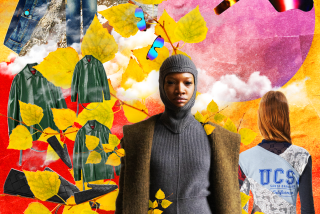Soft Fabric, Hard Supply Problems : Cashmere: It’s Taking Off in Popularity and Price
- Share via
Judy Leaf of Beverly Hills admired some $400 cashmere shawls in London about five years ago, so when a friend went there recently Leaf asked her to get three of them. After seeing the bill for $2,100, Leaf said, “I almost dropped dead. It was like a house payment.”
Designer Donna Karan charged stores $195 a pair wholesale for her first 100% cashmere pants in 1985. By next fall, they are expected to be almost $425. That means that the cost at retail, typically a 100% markup, will have more than doubled to a whopping $850 in just four years.
Such spiraling prices are enough to make a dyed-in-the-wool cashmere fan bleat. More than ever, this soft, luxurious fiber is becoming an option only for the extremely well-to-do. To borrow from F. Scott Fitzgerald, the rich are different from you and me. They can afford cashmere.
Mary Tyler Moore wears it, as do Princess Di, Cheryl Tiegs, Oprah Winfrey, Marlo Thomas, Jacqueline Kennedy Onassis, Pearl Bailey, photographers Richard Avedon and Francesco Scavullo, Jaclyn Smith and Cher. Designer Valentino frequently pops into a Madison Avenue boutique to buy cashmere ties, even though he designs his own in silk. Designers such as Karan, Ralph Lauren, Michael Kors and Bill Blass are increasingly using cashmere in their lines, creating more awareness and demand among the status-conscious.
It is, after all, the late 1980s, when baby boomers have come of age financially and developed a seemingly insatiable appetite for luxury goods--everything from cashmere to crystal to crocodile handbags.
To Karan, whose cashmere body suits are selling this year for nearly $800 at retail, it is “the ultimate fabric, the softest, the finest. It’s like the fur of fabrics,” said Patti Cohen, a spokeswoman for the New York designer. “Donna is never caught without her cashmere blanket,” a big, fringed shawl that she sports along with her trademark sunglasses.
“There are so many people who can afford it and want to imagine themselves living a luxurious life,” said Adrian Mnuchin, creator of Cashmere Cashmere, a three-store chain. “The cashmere way of living is what they’re trying to obtain.”
But lately it has been costing a lot more to obtain because of supply problems in China, the prime source of cashmere, and the rising cost of imports.
This rare hair comes from goats that live in the rugged mountains of China, Mongolia, Tibet, Afghanistan and Iran. (Kashmir, the disputed region between India and Pakistan that gave the fiber its name, no longer produces significant amounts.) China is the largest producer and the source of what is regarded as the finest fiber. And therein lies one reason for the recent dramatic price increases.
Producers Demand More
In its push for economic reform, China has granted far greater power to the provinces where cashmere goats are found. For the last two years, farmers and officials in those regions have demanded more money from foreign customers and have begun selling more of the fiber to domestic manufacturers that make garments for export. (Hong Kong, too, is stepping up its production of cashmere garments.)
Those factors make it tougher and more expensive for U.S. and Scottish companies, the world’s best-known manufacturers, to get the raw material they need to make the yarn for knitting or weaving.
Meanwhile, the dollar’s sharp decline has made imported cashmere garments more expensive even as U.S. demand for cashmere has grown. And, increasingly, U.S. buyers are competing with acquisitive Japanese and European consumers who have come to admire cashmere in a big way.
“By creating a very tight supply, and because demand continues to be strong, (the Chinese) are boosting the price of this commodity,” said Joshua R. Lipman, president of Cuddlecoat, a New York maker of cashmere coats under the Christian Dior label.
“We are losing control of the price,” acknowledged He Xinhao, commercial consul of the Chinese Consulate in Los Angeles. Although Xinhao doubts that prices will decline again, he said China is trying to stabilize cashmere prices and supply.
Sky May Be Limit
Until that happens, there is growing concern among retailers and manufacturers that the sky just might be the limit.
“There is a limit in how far you can go making 100% cashmere garments,” said Julie Stern, president of Donna Karan Co. “At some point, customers would say, ‘That’s ridiculous.’ ” For next spring and fall, he said, the company expects to use more blends of cashmere and silk or wool to help hold down prices.
Even an affluent customer like Leaf, whose husband is a plastic surgeon, cringes at the “horrific” prices. “Regardless of what I buy, I absolutely choke to death, walk around the block 10 times and sleep on it” before deciding, she said, adding: “If prices weren’t so high, I would buy more.” She recently balked, for example, at paying $1,300 for a simple Chanel cashmere dress.
Carolyn Egan, the cashmere specialist at Tobe Report, a trade publication, figures that the high prices will keep cashmere from “being looked at as a realistic gift item. You don’t give it to your sister.”
That said, consider this. Even though the prices of some chi-chi cashmere garments have doubled, many customers’ appetites for them apparently have not diminished--at least not yet.
Expanding Demand
Cashmere specialty stores are appearing in malls and on prestigious shopping streets. I. Magnin in Beverly Hills and Bergdorf Goodman in Manhattan recently opened boutiques called Cashmere & Co. featuring lively, colorful, trendy garments to appeal to younger customers--and designed to be worn nine months a year.
How about a T-shirt for $270 or a pair of bright-red gloves for $145? If those remain out of range for most Americans, they are still far more affordable than a $2,000 Armani cashmere sport coat.
Even in a lackluster Christmas season like this one, stores often cite cashmere as a standout. At its Cashmere & Co. boutique, Bergdorf, according to recent trade reports, had sold 21 pairs of red shorts at $275, 39 blue sailor tops at $325 and 134 pullovers at $425.
In one day this season, Cashmere Cashmere on Madison Avenue in New York sold 10 cashmere warm-up suits ranging from $700 to $1,300. Last August, of all hot, sticky months, it sold three $2,100 cardigans the afternoon they arrived.
Cashmeres of Scotland, which opened at South Coast Plaza in Costa Mesa last April, reports that classic men’s V-neck sweaters and ladies’ sweaters with rounded collars are moving well despite sticker shock.
‘Going to Buy, They Buy’
“If people are going to buy cashmere, they’re going to buy it,” said Mary Sjoberg, the manager. “Even though the price increases have been substantial, the market doesn’t appear to have taken a beating.”
Part of the reason might be that Americans are looking for clothing built to last. “Cashmere is probably a paramount example of investment clothing,” said Boris Shlomm, president of Amicale Industries, a New York company that spins cashmere yarn.
Barneys New York, an upscale clothier, was able to hold the line on prices this fall by signing its cashmere contracts before the latest rash of price increases. Some sweaters selling elsewhere for $350 were $295 at Barneys this season, according to Jody Kuss, merchandise manager for men’s furnishings.
But next year those same items will “probably be no less than $375, and that will be tight,” she said. “It’s a very difficult situation. Prices are sky high.”
As a hedge, Barneys plans to expand its offerings in single-ply cashmere (the more plies in the yarn, the more luxurious and expensive the garments). These lighter-weight garments such as polo shirts and mock turtlenecks can be worn more comfortably under blazers and cost about 25% less than heavier items, Kuss said.
Emphasis on Style
At Saks Fifth Avenue, the emphasis has been on style. “It’s very difficult to keep a lid on prices,” said Mara Urshel, senior vice president and general merchandise manager of sportswear. “We try to compensate by giving . . . more style, more fashion.”
This holiday season, Saks’ best-selling Scottish cashmere items were in fuchsia, jade and hot pink, as opposed to the more traditional beige, red and yellow.
Dawson International U.S.A., the domestic arm of a British firm that is the world’s largest processor of raw cashmere, is hoping to capture younger customers with the more fashionable, casual designs featured in its Cashmere & Co. boutiques. “The traditional Scottish approach . . . has been that cashmere is such an expensive item that garments should be designed to last forever,” Irwin Joffe, president, said. “(But) America is a very fashion-conscious market.”
Next year, the company plans to add 15 Cashmere & Co. boutiques to the five it now operates in specialty stores. It also last January bought Mnuchin’s Cashmere Cashmere chain, which is about to open a fourth store. Dawson’s brands include some of the biggest names in cashmere, including Braemar (the world’s oldest cashmere label), Pringle, Ballantyne and Barrie. In the United States, it also is the Oscar de la Renta cashmere licensee.
‘Business Is Booming’
“Cashmere has never created such interest before,” Joffe said. “From our point of view, business is booming.”
Even longtime devotees sometimes stumble awkwardly in trying to explain cashmere’s appeal.
“It has a sensuality of feeling, a sexualness of touch, a fragility that is generally not long-lasting, although we tend to like our cashmeres when they are a bit worn and used,” one retailer of cashmere garments gushed.
The fabric has a rich history. Roman emperors sent merchants to the Indian region of Kashmir to buy cashmere shawls woven in the city of Srinagar. In the days of Kublai Khan, herdsmen packed the fiber over mountain passes. In the 1800s, Empress Eugenie, wife of Louis Napoleon, Napoleon III of France, introduced cashmere shawls and yarn to a wide European audience.
As in days gone by, the fibers are culled from sturdy little goats for which the downy hair is protection against bitter mountain cold and winds. Each spring, the hair molts, clinging to the coarse outer hairs. Goatherds painstakingly comb away the soft hair by hand, gathering only four or so ounces from each goat. (Shearing, the common method of stripping wool from sheep, plays no part in this fragile process. Although many people--and most dictionaries--refer to cashmere as a wool, the Wool Bureau, a trade group, promotes only wool from sheep.)
Sorted by Grades
At warehouses, the fiber is carefully sorted by grades according to color (black, gray or white, with white being the most expensive because it can be used as is or dyed any color), coarseness and other factors.
It is then bought by manufacturers, who wash the fiber, dye it and spin the yarn for weaving or knitting. Each man’s V-neck sweater, by the way, takes the fibers from three goats. A full-length coat requires the output of 24 goats.
In recent years, efforts to raise the goats in Australia, New Zealand, Scotland and even the United States have met with only limited success. It seems that the harsh conditions of the goats’ native lands stimulate growth of the down, but milder climates do not.







